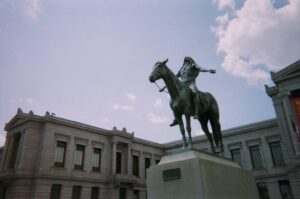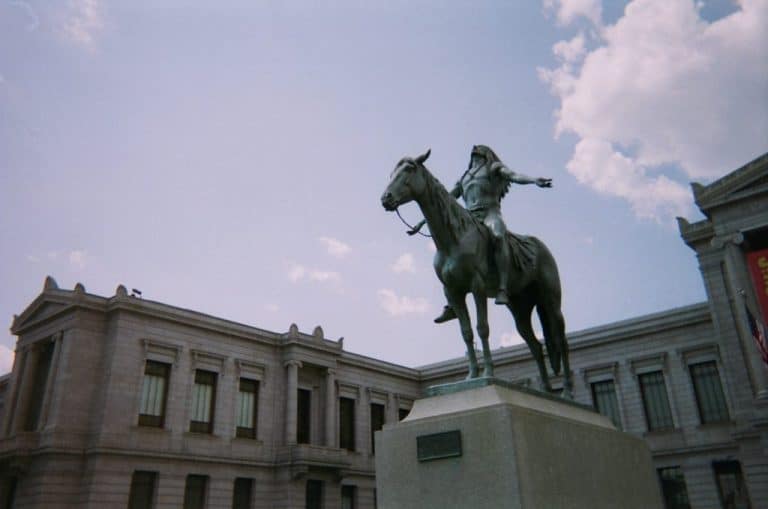 by Anelise Leishman
by Anelise Leishman
On July 4, 2020, the Black Student Union at BYU addressed a letter to the university’s president Kevin J. Worthen, Russell M. Nelson, and the NAACP. In it, black students call for the “retroactive unnaming” of buildings across campus — not just those named for racist leaders of the church’s past like Abraham O. Smoot, but all buildings indiscriminately.
This is a bold idea, one that may seem extreme at the outset. I confess I am still trying to wrap my head around what that would look like. But I think an idea like this gets to the heart of a major cultural shift that has happened in some areas of our lives, but not others — a shift away from the idolatrous approach we take when it comes to our historical figures, especially in America.
As more and more Americans are waking up to the realities of racism and its legacy, we seem to be having a national reckoning about our complex history as a country and its reflection in our culture. So I want to approach this topic by drawing a comparison to a similar phenomenon within Mormonism. For a few years now, the church has been making efforts to reframe their complicated past and acknowledge controversies in order to reprioritize church culture and emphasize what matters most — the gospel.
America is now going through a similar metamorphosis. We should let it happen.
—
Thomas Carlyle was a British historian, essayist, and cultural critic. He is chiefly known for propagating the “great man” theory of history, in which the teleological narrative of human progress is moved forth by monumental decisions made by “great” men. While this theory has been a popular guiding principle for many, it was met with criticism by Carlyle’s contemporaries, and moreover doesn’t really work for us in the modern day — after all, we know that people are in some measure products of their environments, and these figures often serve to distill or popularize ideas or innovations that were already in motion before they ever arrived on the scene. We hail Gutenberg as the inventor of the printing press when we can’t in good conscience give him full credit. For centuries, we identified Columbus as the discoverer of the “new world” when he most certainly wasn’t.
But the great man theory is popular for the same reason HBO’s Chernobyl decided to make Emily Watson’s character a stand-in for countless scientists who made important contributions at the time — because it’s really easy. And to simplify history, often so enormously complex, in this way is a reductive and dangerous thing to do. Not only does it perpetuate the myth of perfect or near-perfect people and facilitate the emergence of cults of personality, but it keeps us from learning about and valuing the progress made by widespread movements that involved collective action and cooperation.
And of course, people have always been messy. Anyone who has read the Bible can acknowledge that many of the great men in those pages did some not-great things — who can forget that one time Moses committed murder? And yet we make idols out of people when we should know better. A common criticism of Mormonism is that members “worship” Joseph Smith. Unfortunately, that’s not terribly far from the truth, although that mindset seems to be gradually fading away.
I think at this point, church leadership has recognized that many millennials, upon discovering the truth about Joseph Smith’s polygamous adventures and other fun quirks not often advertised in Sunday School, are suddenly thrust into a crisis of faith that they may not emerge from with their testimony intact. In The Next Mormons, Jana Riess found that millennials have only a 46% retention rate in the church, with issues surrounding Joseph Smith and church history as a prominent factor. When asked why they left the church, one of the top responses included: “I did not trust the Church leadership to tell the truth surrounding controversial or historical issues.”
In response, leadership has made an effort in official church communications to normalize discourse around those aspects of the past that were so long taboo — for example, the Gospel Topics essays now serve as a resource for members and seek to preempt popular criticisms of the church. You could even say that the recent publication and promotion of the compendium of church history — aptly titled Saints — places some relative distance away from the man, and centers more on a movement of people who felt compelled enough by his teachings to give up their livelihoods for it. We no longer talk about having a testimony of Joseph Smith — we talk about gaining a testimony of the restored gospel. This is a restructuring of church history as a movement of many people gathered around a set of ideas, rather than another ode to an influential, but imperfect man.
Just as the millennial testimony often crumbles when faced with Joseph Smith’s complexities, many Americans are having their own painful crisis of faith when current events force them to reckon with their homeland’s bloody foundations and the way they linger on in our lives today.
—
I know this comparison isn’t perfect. For one thing, the church itself is a product of and is undeniably informed by Christian identity, American exceptionalism, and manifest destiny to begin with. Moreover, I think the church should be doing more as an institution to make amends for how black members have been treated in the past, and I believe that America should likewise be hard at work remedying the causes of systemic racism rather than making cosmetic touch-ups to their wokeness factor and calling it a day.
Some people may not find the church redeemable, while they find that America is, or vice-versa. But the main point I want to make is that this national effort to wrestle with our own past is not an attempt at revisionist history. The point of taking down certain statues or renaming certain buildings isn’t to “cancel” important historical figures and pretend they never existed. Rather, it is an attempt to give historical figures their proper priority.
Just like a member of the LDS church can go their whole lives without facing the more difficult aspects of church history, students in America can go their entire education without truly reckoning with the fact that America would not be the world power it is today without the large-scale oppression and extermination of indigenous and enslaved people. This is because we’ve iconized figures through statues instead of understanding them as human beings who helped uphold systems of oppression. Carlyle’s “great man” theory isn’t compatible with a 21st (or, arguably, even a 20th) century understanding of our world, so why is it still such an integral part of our approach to US history and national identity? As a result of the “great man” theory in action, too many folks born in the United States aren’t equipped with the tools they need to understand our national narrative, one that is far too complex to be told by something as reductive and simplistic as a statue that can only say one statement about one person.
To me, the most powerful American monuments are those that symbolize multifaceted movements, complex histories, and thousands of people united towards a worthy cause — like the Vietnam Memorial in DC, the Tomb of the Unknown Soldier in Arlington, and the Minute Man statue in Concord, MA. History isn’t the sum total of a few men who were considered “great” by the standards of their time, but rather the ideas that have shaped our own, and the many, many men and women who united around them. That’s much more representative of historical fact than Carlyle’s “great man.” It’s not as easy to cast in bronze and it doesn’t make a great sound byte, but it’s more honest and true to life.
When the Black Student Union at BYU calls for renaming of buildings, they aren’t calling for an erasure of church history, but for creating an environment where all can feel that they are valued children of heavenly parents and equal members of both a nurturing church community and an edifying educational institution — something that is clearly not a reality at BYU right now.
When Sen. Tammy Duckworth and others say we should at least consider arguments to take down statues of beloved figures from America’s past, it’s not because they hate America. It’s because they love it enough to be loyal to the inspired ideas — not the “great men” — that made this country what it is. Ideas that we have not yet fully realized, and won’t until equality of opportunity exists for everyone beneath the flag. Do we love our country enough to carry it to its full potential? To have it live up to its promise?
What we’re seeing is America’s testimony of itself crumbling while many find themselves needing to reconcile their love for their country with its egregious past. In order to do so, we need to move away from idolatry and towards realization, from the former law to the higher law. Time to move on from hero worship as a way of life and towards the ideas that will always outlive and outlast them.
Anelise is a BYU English grad and an avid writer, podcast listener, and general consumer of media. You can find more of her work at aneliseleishman.com.






3 Responses
I love your thoughts here. I have been pondering many of the same things the last few years since I read Harper Lee’s Go Set a Watchman, which was sort of a sequel to To Kill a Mockingbird. I know that many, many people who love Mockingbird just hate Watchman, and I think it is because they can’t bear to have their hero tainted in any way. But I really believe that if we are looking for heroes to be near-perfect and do monumental tasks, then we are probably shirking in our own duty to be part of the solution to the problems that still exist in our world. At least that is what I have decided for myself.
Thank you for your post, Anelise. This is a critical time for our country and the church and its institutions of learning, like BYU, to take a firm stand against racism and white supremacy in all its forms and to finally begin to try to right the wrongs of our violent and inhumane treatment of Black Americans. Renaming buildings is the least we can do. You said it so well: “Time to move on from hero worship as a way of life and towards the ideas that will always outlive and outlast them.”
Thanks for this thoughtful post. Even outside history, in daily modern life, I frequently see people ignore the work of many to worship a solitary hero, as of that person has done it all all alone. And yes, very few heroes, modern or historical, lacks flaws.